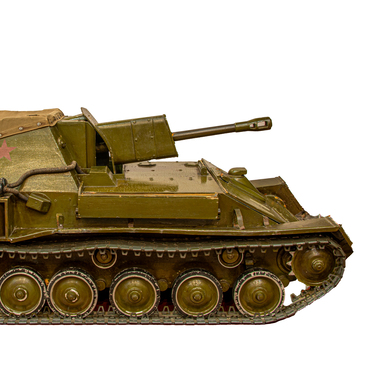A Special Design Bureau for smoothbore artillery of People’s Commissariat for Arms (SKB NV) was created on April 11, 1942, by a Decree of the State Defense Committee. Kolomna Machinery Design Bureau had this name from 1942 till 1956. There they modernized the existing mortar system as well as designed the new ones. The enterprise was headed by the Soviet designer Boris Shavyrin.
In 1956, the Design Bureau started to develop guided missiles. The museum’s collection contains models of missiles from those times.
The first Soviet anti-tank guided missile developed by the company was the Shmel (‘Bumblebee’). It was put into service in 1960, but was produced for a short period of just five years. The second anti-tank guided missile Malyutka, which had also been developed at the Kolomna Design Bureau (SKB), was put into service in 1963. This complex was used in the Vietnam War from 1955 to 1975.
However, the ‘Malyutka’ was massively used during the Arab-Israeli conflict in 1973. Israel ground troops were significantly damaged by this missile system. The ‘Malyutka’ was produced from 1963 till 1984. The system showed its effectiveness in more than 10 military conflicts.
In 1971, the Machinery Design Bureau under the leadership of designer Sergei Invincible began the development of the ‘Igla’ portable anti-aircraft missile system. In 1981, its simplified version — ‘Igla-1’, entered service. It is its model that is displayed in the museum.
The tactical guided missile system ‘Tochka’ and its improved version ‘Tochka-U’ with the 9M79-1 missiles was another successful development. At ‘Tochka-U’, the composition of the rocket fuel was changed, the control devices were modernized, and the flight range was increased from 70 to 120 kilometers.
The model of ‘Tochka-U’ in the museum collection can be compared with the ‘Tochka’ itself in real size, it is located on the territory of the museum. The Strategic Missile Forces of the Russian Federation have used these complexes as their main weapon for over 20 years. By 2018 — during the rearmament — their number was considerably reduced. Now the complex has been removed from service in Russia, but it continues to be used in other countries.
In 1956, the Design Bureau started to develop guided missiles. The museum’s collection contains models of missiles from those times.
The first Soviet anti-tank guided missile developed by the company was the Shmel (‘Bumblebee’). It was put into service in 1960, but was produced for a short period of just five years. The second anti-tank guided missile Malyutka, which had also been developed at the Kolomna Design Bureau (SKB), was put into service in 1963. This complex was used in the Vietnam War from 1955 to 1975.
However, the ‘Malyutka’ was massively used during the Arab-Israeli conflict in 1973. Israel ground troops were significantly damaged by this missile system. The ‘Malyutka’ was produced from 1963 till 1984. The system showed its effectiveness in more than 10 military conflicts.
In 1971, the Machinery Design Bureau under the leadership of designer Sergei Invincible began the development of the ‘Igla’ portable anti-aircraft missile system. In 1981, its simplified version — ‘Igla-1’, entered service. It is its model that is displayed in the museum.
The tactical guided missile system ‘Tochka’ and its improved version ‘Tochka-U’ with the 9M79-1 missiles was another successful development. At ‘Tochka-U’, the composition of the rocket fuel was changed, the control devices were modernized, and the flight range was increased from 70 to 120 kilometers.
The model of ‘Tochka-U’ in the museum collection can be compared with the ‘Tochka’ itself in real size, it is located on the territory of the museum. The Strategic Missile Forces of the Russian Federation have used these complexes as their main weapon for over 20 years. By 2018 — during the rearmament — their number was considerably reduced. Now the complex has been removed from service in Russia, but it continues to be used in other countries.



